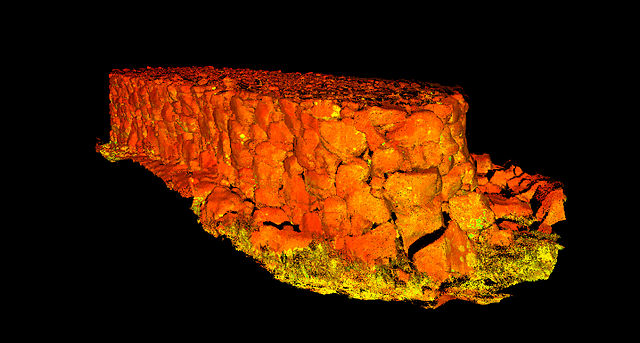 |
This is a file from the Wikimedia Commons. Information from its description page there is shown below.
Commons is a freely licensed media file repository. You can help.
|
Summary
| DescriptionRapa nui cyark 2.jpg |
English: Translated from the term Hare Moa, the Chicken House ruin is a stone construction of a type particular to the Polynesian culture of Rapa Nui. The Hare Moa are the most abundant free-standing permanent constructions on the island;1233 of them have been counted. Built from small pieces of basalt, these structures generally measure around 10 feet wide, 6 feet tall, and 20 feet long, though some examples measuring up to 70 feet in length have been found. The Hare Moas' inner chambers often have both human-sized and animal-sized (chicken) entrances. Evidence points to the use of many of the Hare Moa as coops for chickens during later archaeological periods, though quite a few seem to have originally been built as tombs in earlier phases (pre-protohistoric period) then later re-used as coops. In the case of smaller Hare Moa with no side openings and ill-defined roofs, they served as storage for tubers such as sweet potato and taro. The well-protected nature of these chicken coops could be reflective of the decline of food sources on the island, as well as a dearth of wood and/or reeds that would have been used to build thatch coops in earlier times.
|
| Date |
|
| Source |
http://archive.cyark.org/hare-moa-chicken-house-scan-shot-1-media |
| Author |
CyArk |
Licensing
File usage
The following pages on Schools Wikipedia link to this image (list may be incomplete):
This file contains additional information, probably added from the digital camera or scanner used to create or digitize it. If the file has been modified from its original state, some details may not fully reflect the modified file.
Wikipedia for Schools brings Wikipedia into the classroom. Our 500 Children's Villages provide a home for thousands of vulnerable children. Beyond our Villages, we support communities, helping local people establish better schools and delivering effective medical care to vulnerable children. There are many ways to help with SOS Childrens Villages.


